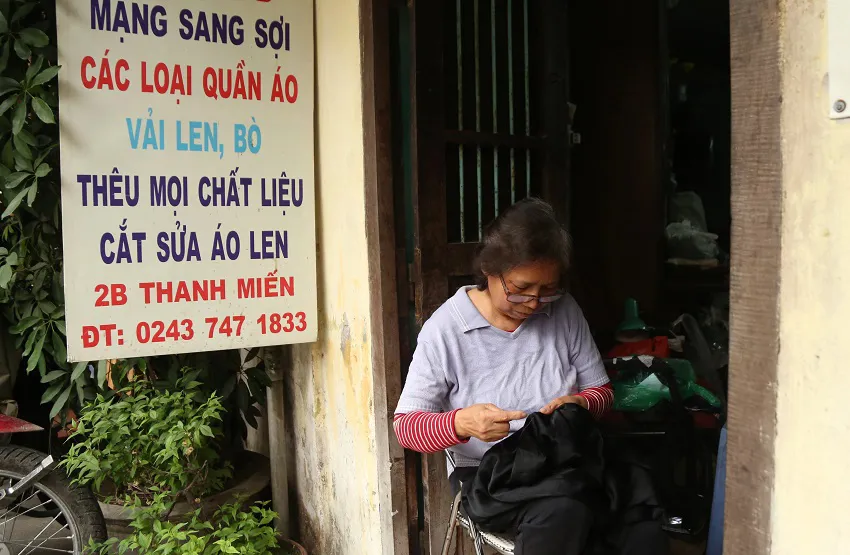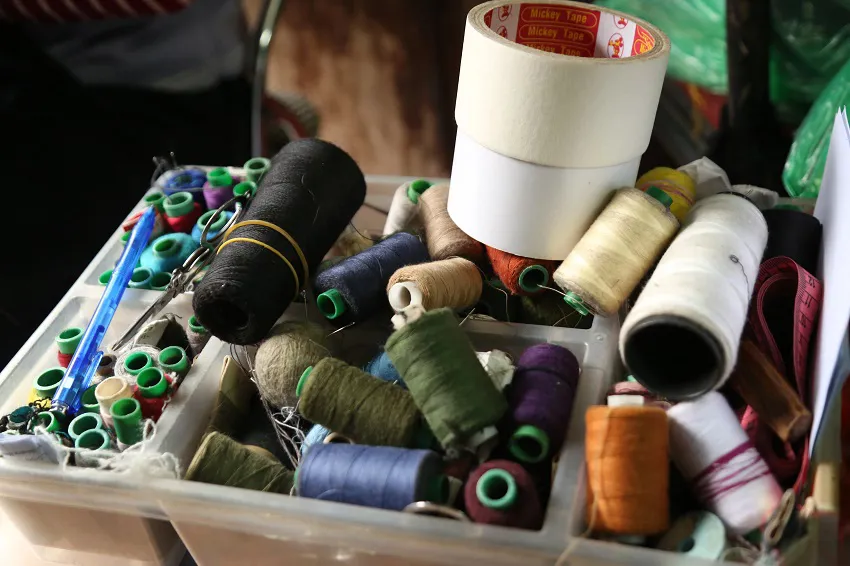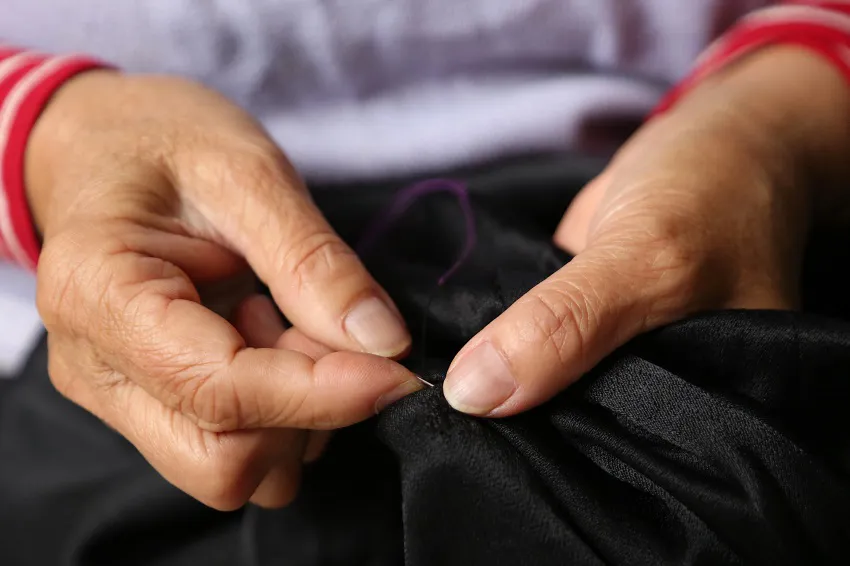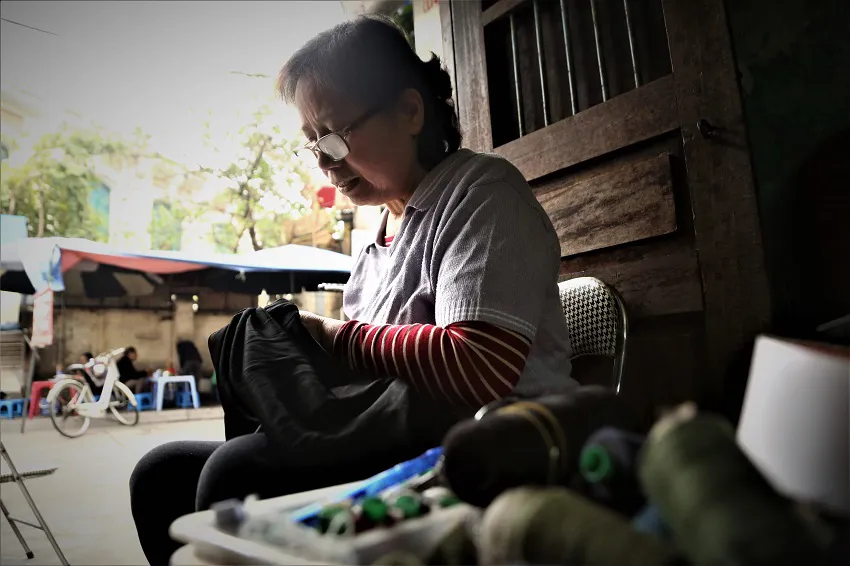Rare female artisan who patches up memories in Hanoi
Darning clothes work requires meticulousness, ingenuity and patience, and thanks to that, it brings a decent income for the 72-year-old craftwoman in Hanoi.
Just a few steps away from the bustling street, Nguyen Thi Hong has been attached to a craft that she has followed from her 20s. For many people, she is one of the few remaining talented artisans in the capital.
The quintessence of a past generation of Hanoian women
| Nguyen Thi Hong has been spending over 40 years yarning clothes in Hanoi. Photo: Dan Tri |
Residents of Thanh Mien Alley in Van Mieu Ward in Dong Da District, Hanoi are so familiar with the sight of Nguyen Thi Hong, a small grey-haired woman sitting in front of her tiny house - numbered 2B - and quietly yarning clothes.
Since 1979, she has always been there on the old chair, sitting on an old chair next to a toolbox filled with needles, strings of all colors, scissors, point-pens, memo papers, tape measures and other items.
Inside the house filled with old scents and antiques, there is a tall wardrobe full of shirts, pants, scarves and socks received from customers for repair.
Life has changed a lot. Nowadays, tailor shops and clothing stores have sprung up, but Hong's garment repair shop is still known and frequented by many people.
Even a wealthy family on Kham Thien Street has, for the past 20 years, brought her everything from cheap scarves to costly coats to this skillful woman.
No matter how bad a tear, Hong can always yarn the garment so well that a normal person wouldn’t even notice the yarn.
While slowly yarning the sweater that she received in the morning, Hong recalled the days when she was just a beginner: “Almost all Hanoi women in the past were good at needlework. I was taught the craft by my mother-in-law, Ta Hue Diep, when I was 29 years old.”
| The simple working tools of Hanoian craftswoman. Photo: Dan Tri |
Hong's husband, Nguyen Anh Dung, recalled: “My mother used to be one of the most famous seamstresses in the capital. She used to mend extremely expensive outfits for Western officials in a tailor shop near Hoan Kiem Lake.”
Besides Hong, Diep also passed craft on to her own three daughters, all of whom later opened dressmaking shops and hired employees.
Hong said she is happy that many people came to interview her for newspaper articles, books and films. For her decades-long craft, Hong's name was listed in the Thang Long Imperial Citadel as one of Hanoi's rare living dressmakers.
Patching up memories of people
Although she is no longer as agile as her younger self, Hong can still fix each garment within one or two days. This is how her mother-in-law raised four children, and she raised her son to be a healthy and successful man.
Without a large shop or employees, Hong will never become rich, yet she is content with her peaceful, comfortable life.
“I never get bored except in times of sickness. I have one job, but every day I fix a different rip, no two are the same. The income from repairing clothes is pretty good, enough for an elderly couple to live together,” she said.
“Normally, I charge 50 only thousand dongs (US$3) for a simple yarn, while more sophisticated ones - due to the fabric or the weave - may cost a few hundred thousand ($10 above), for example, blousons”, she went on.
| A profession that requires a craftswoman's ingenuity and perseverance. Photo: Dan Tri |
Hong calls herself the “memory patcher”, as - although she does repair new garments with defects - most of her customers entrust her with their favorite or gifted items, which they don’t want to throw aside or away.
“Many years ago, when the monsoon set in, an old woman came and asked me to mend an old worn-out cotton jacket.
At first, I hesitated and told her that the jacket was so torn to mend and would cost a lot of money, so she would be better off spending the money on a new one.
But the woman begged me to do, saying that no matter how much it would cost her, she had to have it fixed to wear since it was a gift that her dear son had bought her as the last gift before he died.
There are also foreigners from faraway lands carrying bags of clothing to her shop. Some babble in Vietnamese about being referred to Hong by friends, while others read about her in the newspaper.
When getting their items back, they often give her tips, but Hong always refuses to take only a few dollars - the same as for Vietnamese customers. Moreover, she also graciously advised them how to wash and keep their clothes.
The smiles and thanks of her customers are the simple yet precious happiness for the woman who spends most of her life darning clothes at her door.
| The Hanoian woman helps people to patch the priceless memories in life. Photo: Dan Tri |















